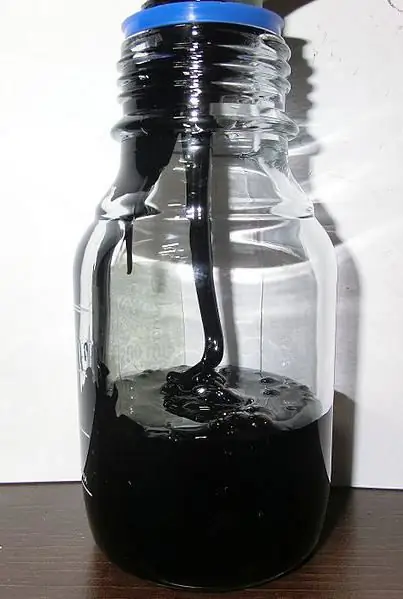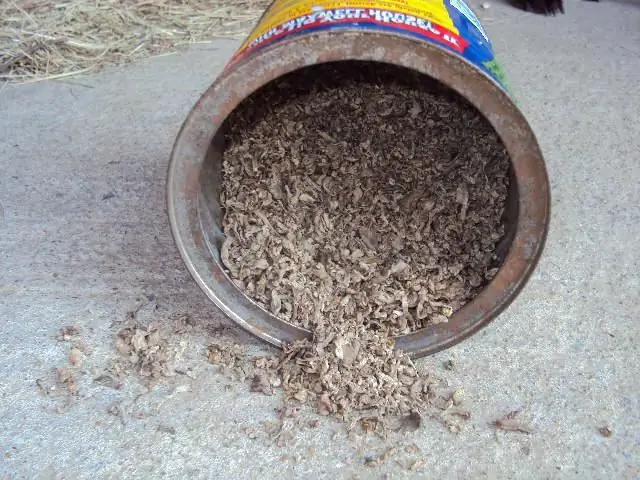2026 Author: Howard Calhoun | [email protected]. Last modified: 2025-06-01 07:12:56
Tall oil is produced by kraft pulping. Fatty acids, which are obtained from crude oil, are widely used: the production of soap, paintwork materials, epoxy resins, adhesives, use as additives in the manufacture of various materials (rubber, concrete, paper and others).
Description

Tall (sulfate) oil is a liquid mixture of organic compounds (mainly higher fatty and resin acids), which has a dark color and a pungent odor.
The substance has the following physical and chemical characteristics:
- viscosity (at t=40°С) - from 410 to 1660 cSt;
- density at +20 °С - 994-1001 kg/m3;
- heat capacity - from 1.6 to 4.1 kJ/(kg K);
- acid number - 158-163;
- flash point - 221 °C;
- autoignition temperature - 304-311 °С;
- thermal conductivity at normal temperature - 0.13-0.15 W/(m K).
The properties of tall oil (its solidification point, viscosity) are improved by adding additives from phenol-formaldehyde resins, alcohols and othersconnections.
Density, resin acid content, acid number and saponification number depend on the composition of the raw wood (in order of decreasing values of these indicators):
- conifers;
- mix of softwood and hardwood;
- hardwood.
S alts of tall oil acids are called tallates.
Receive

Sulfate pulping is carried out by treating wood chips with an aqueous solution of sodium hydroxide and sodium sulfide. At present, this technology is one of the leading ones in pulp production. Under the action of the above reagents, resin and fatty acids are saponified. They turn into black liquor, which is a sulfate soap. The latter is fully used for processing into tall oil.
Evaporation of lye leads to the separation of a fraction of low density, which floats to the surface. The yield of the substance is in the range of 100-140 kg per ton of raw material. Crude tall oil is produced by 2 methods:
- Periodic. The sulfate soap is pumped into the reactor where it is exposed to a 30% H₂SO₄ solution. The decomposition process lasts 2-3 hours, then the same amount of time the mixture settles directly in the reactor. The liquid is stratified into 3 layers, the top layer includes oil. It is pumped out for further washing and drying.
- Continuous. First, the soap is washed with a solution of lye, then passed through a homogenizer and filtered from mechanical impurities. Mixing with H₂SO₄ is carried out continuously in a pump. Separation into fractions takes place in a separator, from which all components are quickly removed to tanks.
The amount of tall oil produced depends on several parameters. This is:
- composition of source material;
- humidity of sulfate soap;
- the quality of its washing;
- careful separation of fractions (the middle fraction, consisting of lignin, can take up to 50% of the oil with it);
- decomposition technology.
Composition

The following main factors influence the chemical composition of oil:
- type of wood and its breed;
- time of the year during which raw materials were harvested;
- duration and method of wood storage;
- process conditions.
Tall oil contains the following substances:
- resin, or rosin, acids (palustral, abietic, neoabietic, dihydro- and tetrahydroabietic) - 40-45%;
- unsaturated fatty acids (oleic, stearic, linolenic, linoleic, palmitic) - 40%;
- unsaponifiable substances (aliphatic, diterpene hydrocarbons, stearin, phytosterol, alcohols and others) - 12%;
- hydroxycarboxylic acids - about 5%.
Cleaning without distillation

The individual components of tall oil are of the greatest practical value. The separation of fatty acids and other constituents is done in several ways:
- usingsolvents and their mixtures (liquid propane, furfural, diacetone alcohol, gasoline hydrocarbons and others);
- reacting with urea;
- decarboxylation (if only fatty acids need to be isolated);
Distillation
In industrial conditions, fractionation is carried out using a two-stage technology:
- Distillation. When heated to 200 ° C, volatile substances are distilled off from tall oil.
- Rectification (mixture separation due to mass and heat exchange with steam).
Another way to modify oil is oligomerization, which results in fatty acid dimers. At technological plants in the USA, this process is carried out at a temperature of 230-250 ° C, under pressure and in the presence of a catalyst - montmorillonite. In Russia, oligomerization is carried out by the autoxidation method. Tall oil is heated to 195 ° C, while continuously passing air through it.
Application

After distillation and rectification, several types of organic compounds are obtained, which are widely used:
- Tall oil fatty acids up to 97% pure (paint and printing industry).
- Tall rosin (paper and soap production, manufacture of adhesives for cardboard and paper, cable industry).
- Distilled tall oil (soap making, production of varnishes, resins, paints, emulsifiers, linoleum; rubber regeneration, introduction as a binder into sand-clay castingshapes).
- Tall pitch (asph alt, fiberboard production).
Oil in its raw, undistilled form is used for the following purposes:
- Fibreboard impregnation for hardening and hydrophobization;
- additive in the production of mineral and glass wool (improvement of strength properties in high humidity conditions);
- manufacture of flotation agents-foaming agents;
- softener for rubbers;
- production of resins and paints and varnishes (paints, varnishes), plasticizers;
- lubricants and lubricants for textile processing;
- additive to bitumen to improve its adhesive properties.
Tallates are used in the manufacture of the following substances:
- oil paints and varnishes (additive to speed up their drying);
- catalysts for chemical reactions;
- insecticides;
- wetting agents;
- asph alt and wax hardeners;
- waxed paper for corrosion protection.
Tall oil also contains a high amount of sterols (up to 3%) compared to other vegetable oils. These substances are biologically active and promising for use in medicine, cosmetology and the food industry.
Recommended:
Production of olive oil and the cause of bitterness. Wood oil - what is it?

The European olive is an amazing tree with a lifespan of about 500 years! Moreover, its oils are endowed with a healing and simply beneficial effect. European olive oil is applicable in medicine. Often they relieve the symptoms of burns. In cosmetology, olive oil is used as a rejuvenating product of natural origin. We will also answer the question: wood oil - what is it?
Oil is a mineral. Oil deposits. Oil production

Oil is one of the world's most important minerals (hydrocarbon fuel). It is a raw material for the production of fuels, lubricants and other materials
Oil production in the world. Oil production in the world (table)

The world as we know it would be very different if there was no oil. It is hard to imagine how many everyday things are created from oil. Synthetic fibers that make up clothing, all plastic used in everyday life and industry, medicines, cosmetics - all this is created from oil. Almost half of the energy consumed by mankind is produced from oil. It is consumed by aircraft engines, as well as almost all vehicles in the world
Beet pulp granulated: production, application, composition

Beet pulp is a valuable feed product containing a large amount of carbohydrates. It is sold mainly in granules
How is oil produced? Where is oil produced? Oil price

Currently, it is impossible to imagine the modern world without oil. It is the main source of fuel for various transport, raw materials for the production of various consumer goods, medicines and other things. How is oil produced?

